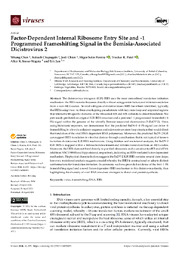Factor-dependent internal ribosome entry site and-1 programmed frameshifting signal in the Bemisia-associated dicistrovirus 2
Factor-dependent internal ribosome entry site and-1 programmed frameshifting signal in the Bemisia-associated dicistrovirus 2
Author(s): CHEN, Y.; CHAPAGAIN, S.; CHIEN, J.; PEREIRA, H. S.; PATEL, T. R.; INOUE-NAGATA, A. K.; JAN, E.
Summary: The dicistrovirus intergenic (IGR) IRES uses the most streamlined translation initiation mechanism: theIRESrecruitsribosomesdirectly withoutusingproteinfactors andinitiates translation from a non-AUG codon. Several subtypes of dicistroviruses IRES have been identified; typically, the IRESs adopt two-to three overlapping pseudoknots with key stem-loop and unpaired regions that interact with specific domains of the ribosomal 40S and 60S subunits to direct translation. We previously predicted an atypical IGR IRES structure and a potential-1 programmed frameshift (-1 FS) signal within the genome of the whitefly Bemisia-associated dicistrovirus 2 (BaDV-2). Here, using bicistronic reporters, we demonstrate that the predicted BaDV-2-1 FS signal can drive-1 frameshifting in vitro via a slippery sequence andadownstreamstem-loopstructurethatwoulddirect the translation of the viral RNA-dependent RNA polymerase. Moreover, the predicted BaDV-2 IGR can support IRES translation in vitro but does so through a mechanism that is not typical of known factorless dicistrovirus IGR IRES mechanisms. Using deletion and mutational analyses, the BaDV-2 IGR IRES is mapped within a 140-nucleotide element and initiates translation from an AUG codon. Moreover, the IRES does not bind directly to purified ribosomes and is sensitive to eIF2 and eIF4A inhibitors NSC1198983andhippuristanol, respectively, indicating an IRES-mediated factor-dependent mechanism. Biophysical characterization suggests the BaDV-2 IGR IRES contains several stem-loops; however, mutational analysis suggests a model whereby the IRES is unstructured or adopts distinct conformations for translation initiation. In summary, we have provided evidence of the first-1 FS frameshifting signal and a novel factor-dependent IRES mechanism in this dicistrovirus family, thus highlighting the diversity of viral RNA-structure strategies to direct viral protein synthesis.
Publication year: 2024
Types of publication: Journal article
Unit: Embrapa Vegetables
Observation
Some of Embrapa's publications are published as ePub files. To read them, use or download one of the following free software options to your computer or mobile device. Android: Google Play Books; IOS: iBooks; Windows and Linux: Calibre.
Access other publications
Access the Agricultural Research Database (BDPA) to consult Embrapa's full library collection and records.
Visit Embrapa Bookstore to purchase books and other publications sold by Embrapa.

